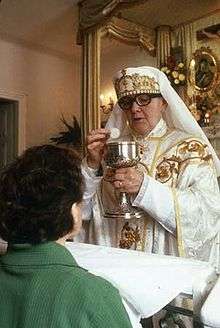Catholic Mariavite Church
| Catholic Mariavite Church | |
|---|---|
|
Mariavite emblem | |
| Classification | Old Catholic |
| Orientation | Old Catholicism |
| Polity | Episcopal/Presbyterial |
| Prime bishop | Maria Beatrycze Szulgowicz |
| Associations | none |
| Region | Poland |
| Headquarters | Felicjanów, Republic of Poland |
| Origin |
1935 Felicjanów, Second Polish Republic |
| Separated from | Old Catholic Mariavite Church |
| Congregations | 17 |
| Members | 1980 |
| Ministers | 11 |
| Temples | 14 |
| Other name(s) | Mariavite Catholic Church |
| Official website |
mariawityzm |
| [1] | |
The Catholic Mariavite Church is an autonomous religious organization in Poland resulting from a schism in 1935 within the Old Catholic Mariavite Church.[2]
Before 1935 schism
After its foundress, Sister Feliksa Kozłowska died in 1921, Jan Maria Michał Kowalski, a Catholic priest, became the leader of the Old Catholic Mariavite Church. He had been Kozłowska's spiritual adviser and confidante. He had been the leader of the failed 1903–1906 attempt to incorporate the Mariavite movement within the Roman Catholic Church and to have Kozłowska's revelations judged by the Roman Catholic Church as worthy of belief. When this attempt was rejected by Pope Pius X, and the Mariavites excommunicated finally in 1906, the then Kowalski set about codifying the movement's doctrines and beliefs in concert with Kozłowska. He found a welcome among the clergy of the Old Catholic Church based in Utrecht, Holland, as they had split from the Roman Catholic Church over the issue of papal infallibility in the 1870s. In 1909, Kowalski was consecrated as a bishop in Utrecht, thus ensuring the Apostolic succession.
However, under his leadership Mariavites dwindled. This was due to the rise of Polish nationalism, in which Roman Catholicism was an intrinsic part of the Polish national identity, and the creation of a sovereign Second Polish Republic in 1918. Another factor in the decline of the group was persecution of the Mariavites by Roman Catholics with the scarcely veiled support of the Polish government. But much of the decline could be traced to factors involving Kowalski himself – his generally autocratic rule of the church as Kozłowska's successor, and innovations that he had introduced which drove him further from the Catholic Church, such as the endorsement of consummated clerical marriages between priests and nuns, and later the ordination of women as priests and bishops, which took him out of fellowship with the Old Catholic movement as well.
After 1935 schism
By 1935, the Old Catholic Mariavite Church clergy deposed Kowalski. He rejected this and moved his headquarters to the village of Felicjanów, named for the foundress. He named his faction the Catholic Mariavite Church, despite its by-now considerable departure from traditional Roman Catholicism, and continued to consider himself as the true leader of all true Mariavites. Freed from the restraining influences of much of the clergy which had formerly been subordinate to him, he declared even more radical pronouncements, the most radical of which was that Kozłowska had in fact been the incarnation of the Holy Spirit upon the earth.
Kowalski died in a World War II concentration camp and was succeeded as the church's leader by his wife, who had been consecrated a bishop. The Catholic Mariavite Church continues to this day and is still based in Felicjanów. It apparently has no adherents outside of Poland, unlike the larger Old Catholic Mariavite Church. Never large to begin with (perhaps 3,000 members at its founding). It is now a true church movement, and finds most ecumenism to be both unnecessary and sinful, since all true believers are to be found within its ranks. This insularity, of course, contributes to a general inability for the group to be penetrated by outsiders to learn details such as its actual current size. This group is led by a bishop who is a woman. While considering itself the true church, the church is very liberal in its theology, unlike most of the Old Catholic Mariavite Church, which retain a certainly moderate-conservative view upon liturgy and theology.
Leaders (bishops)

- 1935–1942: Jan Maria Michał Kowalski
- 1940–1946: Maria Izabela Wiłucka-Kowalska
- 1949–2005: Maria Rafael Wojciechowski[lower-alpha 1]
- 2005: Maria Beatrycze Szulgowicz
Administration
- Two custodies with 16 parishes
Notes
- ↑ Maas consecrated Wojciechowski on 25 November 1956 in Felicjanow.
References
- ↑ Polska. Główny Urząd Statystyczny (2013-03-28). "Kościół Katolicki Mariawitów w RP". Wyznania religijne stowarzyszenia narodowościowe i etniczne w Polsce 2009–2011 (PDF). stat.gov.pl. Warszawa, PL: Zakład Wydawnictw Statystycznych. pp. 46–47. ISBN 978-83-7027-519-8. Archived (PDF) from the original on 2013-10-08.
- ↑ Peterkiewicz, Jerzy (1975). The third Adam. London: Oxford University Press. ISBN 978-0-19-212198-1.
- Melton, J. Gordon, ed. The Encyclopedia of American Religions: Religious Creeds. Detroit:Gale Research Company, 1988. ISBN 0-8103-2132-7.
.png)